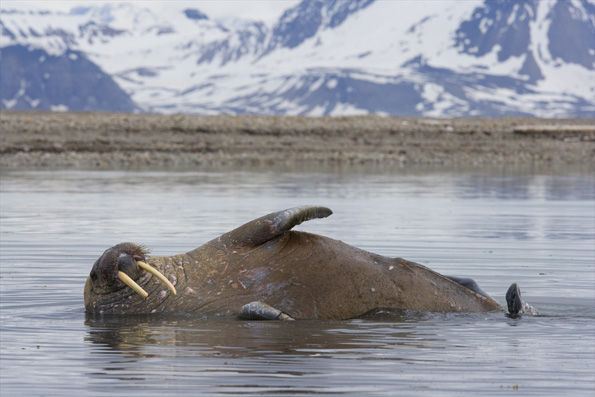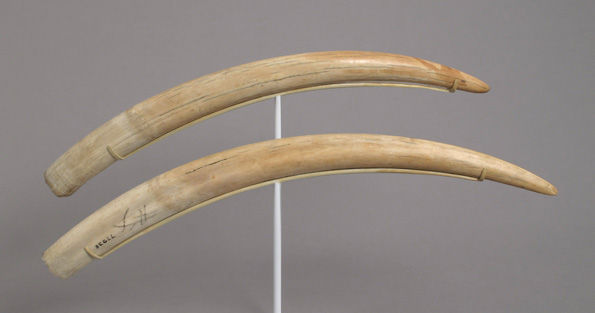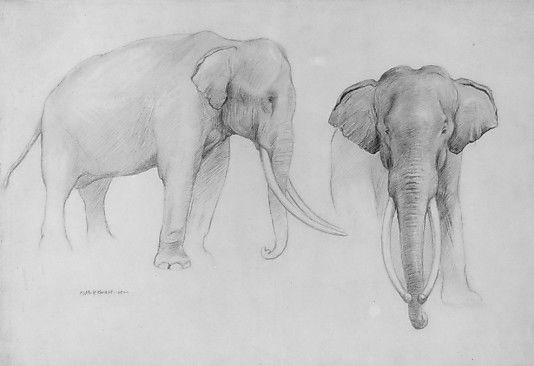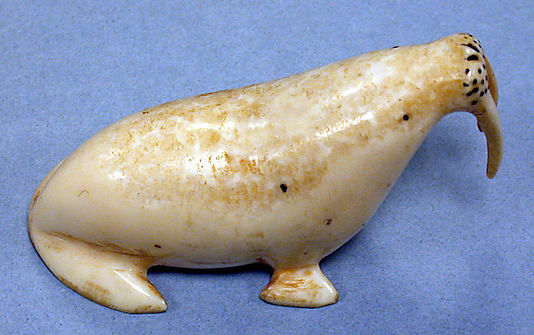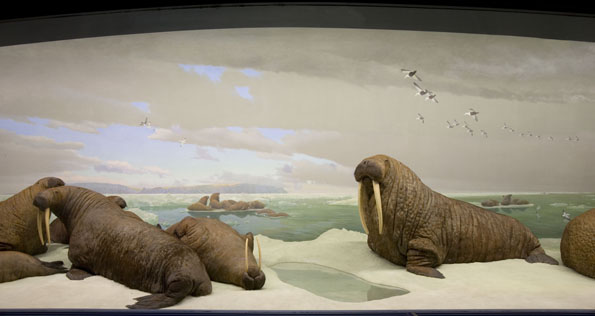The Lewis Chessmen are carved from walrus tusks. We asked Ross MacPhee, Curator of Mammals at the American Museum of Natural History to tell us more about this remarkable creature.
Although the walrus (Odobenus rosmarus) is one of the iconic mammals of the Arctic, its evolutionary story actually began in the tropics. By adapting to cold conditions, the distant ancestors of walruses were able to prosper in the harsh conditions of the northern polar regions. This took time; walruses are distantly related to fur seals and sea lions, but they have been on their own as a separate lineage for more than twenty million years. Although moderately diverse in the past, the walrus family declined over time and is now represented by just one species.
Odobenus rosmarus
No longer hunted in large numbers, O. rosmarus is nevertheless regarded as having an uncertain ("data deficient") conservation status. (The pair of tusks included in The Game of Kings exhibition was collected at the beginning of the twentieth century.)
Pair of Walrus Tusks, American Museum of Natural History, New York (77938). Photo: Thomas C. Vinton. Both sexes of walrus grow long tusks, which can be up to 30 inches long. When removed from the animal, tusks must be carefully dried, or—much like improperly cured wood—they will develop longitudinal cracks that penetrate both cementum and dentine.
The genus name Odobenus, which roughly translates as "tooth-walker," is a metaphoric reference to the animal's use of its massive canines for the very practical purpose of hauling itself out of the water onto a beach or an ice floe. (Actually, like other pinnipeds—seals and their relatives—the walrus mostly relies on sinuous movements of its highly mobile trunk and flippers, not its teeth, to move around on land.) The canines, which are large in both sexes, also feature in combat and protection. Researchers once thought that they were used as the biological equivalent of oyster knives—to uproot and then prize open shellfish—but we now know that the walrus locates clams and other prey by sweeping the bottom of the ocean floor with its whiskery, hypertrophied lips and nasal region. An unlucky prey item is held fast in the front of the mouth while the tongue pumps vigorously, allowing the walrus to vacuum open the shell's valves and suck out its contents.
Typically, a mammalian tooth consists of three kinds of tissue—enamel, cementum, and dentine. Enamel, which forms the hard, external part of the tooth, has a prismatic crystalline structure; it is, in effect, rock. This severely limits its use in fine carving, as enamel tends to shatter when whittled with knife or needle. Cementum is a tissue related to bone that varies greatly among mammalian species in its relative contribution to teeth. It usually forms a thin cap on tooth roots, and is often fairly brittle. Dentine, by contrast, is chiefly composed of a relatively soft, homogeneous intercellular matrix that tends to shear evenly in all directions. Unlike wood there is no, or very little, grain. In most mammals, the dentine is mostly or completely hidden by enamel, but in a few groups the enamel is either absent or is worn away during life.
Charles R. Knight (American, 1874–1953). Indian Elephant, Profile and Frontal Views. Graphite on off-white wove paper. The Metropolitan Museum of Art, New York, Sheila and Richard J. Schwartz Fund and Maria DeWitt Jesup Fund, 1992 (1992.351.3)
In post-juvenile elephants (as well as their extinct relatives, the mammoths), the ever-growing tusks are completely composed of dentine, the tiny amount of enamel capping the ends having long since been worn away. Much the same happens in walruses. There are, however, some marked differences between elephant ivory and walrus ivory. In elephants, the tusks grow incrementally throughout the life of the animal. Increments are produced annually and added to the growing end of the tooth in a process akin to stacking a series of paper cups—one against another in a long chain. In cross-sectioned elephant ivory, one finds a tiny central hole, for conducting blood vessels and nerves, but the tooth is otherwise completely composed of unremodeled, or primary, dentine. In the case of walruses, the tooth also grows throughout life, but its center is taken up by a relatively large pulp cavity around which secondary dentine may form. The outer parts are formed by both primary dentine and cementum. Additional differences are occasioned by the microscopic structure of the dentine: in elephant ivory, this structuring is very apparent and gives the polished cross-section a distinctive look. Structuring of this type is much less obvious in walrus ivory.
Ivory Walrus, ca. 1950. Annawakalook. Canada, Baffin Island, Nunavut. Inuit. The Metropolitan Museum of Art, New York, Gift of James A. Houston, 1969 (69.269.12)
Some have argued that the Lewis Chessmen were created in Iceland rather than in present-day Norway. In this regard, the prehistoric distribution of O. rosmarus may be of some interest. During the last ice age, or Wisconsinan glaciation (about 100,000–10,000 years ago), the higher latitudes of the northern hemisphere were mostly covered by enormous ice masses. In North America, where Wisconsinan ice extended to the latitude of New York City, walrus fossils have been found as far south as Cape Hatteras, North Carolina. In western Europe, Pleistocene walrus fossils are rare, but they clearly enjoyed a range that extended along the margins of the North Sea as least as far south as the northern British Isles. Although the ice progressively withdrew after the end of glacial times, walrus populations would have remained much longer in favorable areas. The famous 1539 Carta Marina, for example, pictures a "rosmarus piscis" coming ashore on the coast of Finnmark, near present-day Tromsø in northern Norway.
Detail from the Carta Marina, showing a walrus swimming off the coast of Norway
Why is this relevant? Some scientists consider that O. rosmarus can be subdivided into Pacific, Atlantic, and the poorly known Laptev Sea populations. There are some genetic differences between the first two populations, which suggest a degree of isolation over a reasonably long period. The Laptev population has not yet been adequately characterized genetically, and some authorities do not regard it as sufficiently distinct to warrant a separate designation. It would be interesting to know whether the ivory of the Laptev and Atlantic populations can be distinguished by analyzing ancient DNA. (Similar techniques have been used to distinguish North American and Eurasian mammoth populations.) A DNA match to the existing Laptev walrus population—whose range includes the Kola Peninsula—might suggest that Scandinavia was the source. On the other hand, if Iceland was the source, any genetic signature recovered from the chessmen should closely conform to that of Atlantic walruses. Thus science may inform art, and vice versa.
Walrus group on ice floes: a diorama in the Hall of Ocean Life, American Museum of Natural History, New York. Photo: (c) AMNH\D. Finnin
—Ross D. E. MacPhee, PhD
Curator of Mammals
American Museum of Natural History
